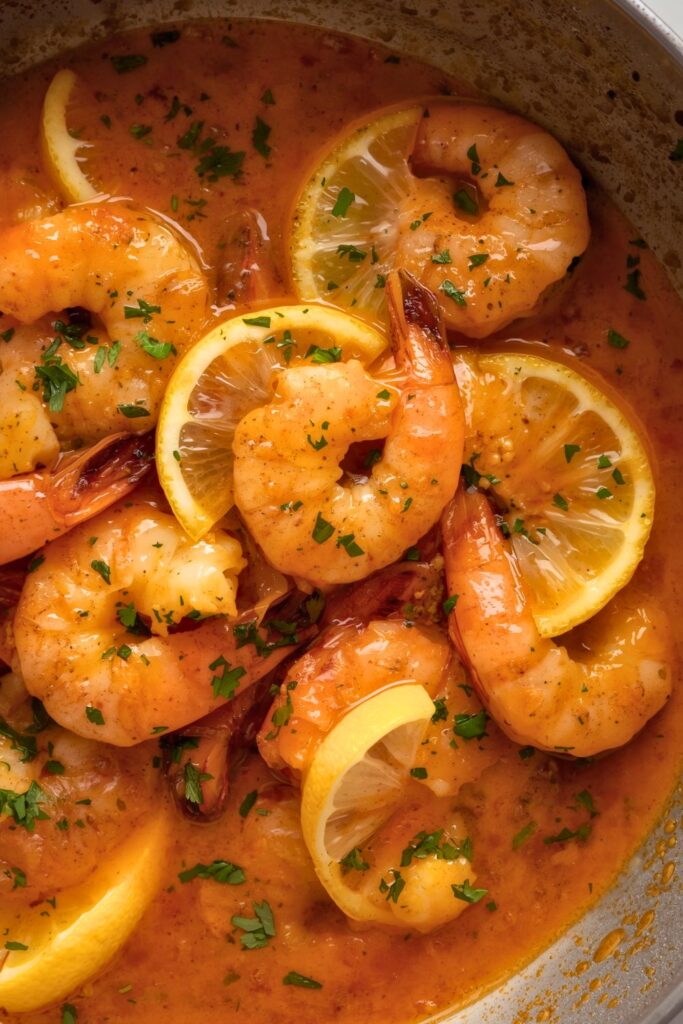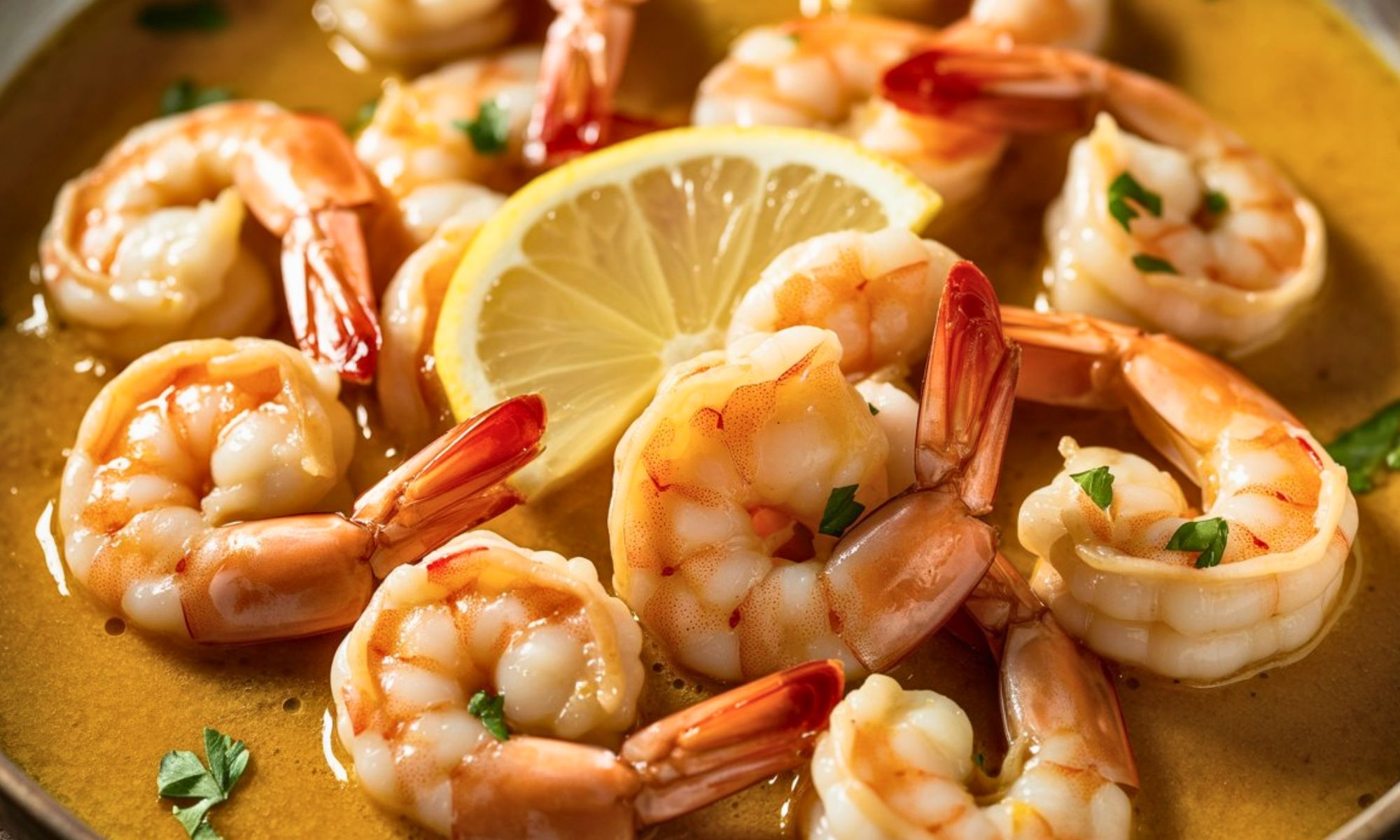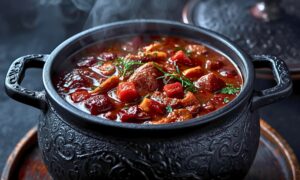The waiter disappeared into that crowded Madrid kitchen and emerged carrying liquid fire. Not literally, of course, but that sizzling cazuela of Spanish Garlic Shrimp with Saffron might as well have been pure magic dancing across hot clay. Golden threads of saffron swirled through olive oil so fragrant I could taste it before the dish even reached our table.
That moment changed everything for me. Not just because the Spanish Garlic Shrimp with Saffron was absolutely incredible, but because I realized I’d been making garlic shrimp completely wrong my entire life. This wasn’t just seafood with garlic thrown on top, this was alchemy.
Three years later, I’ve perfected this recipe through countless attempts, kitchen disasters, and those glorious moments when everything clicks perfectly. Tonight, I’m sharing every secret I’ve learned about creating authentic Spanish Garlic Shrimp with Saffron that rivals anything you’d find in the best tapas bars across Spain.
Why Spanish Garlic Shrimp With Saffron Rules the Tapas World

Most people think Spanish cooking means throwing ingredients together and hoping for the best. They couldn’t be more wrong. Spanish Garlic Shrimp with Saffron represents centuries of refined technique disguised as rustic simplicity.
The magic happens in layers. Saffron doesn’t just color the oil, it transforms every single flavor in the dish. Garlic becomes sweeter, shrimp tastes more oceanic, and that olive oil turns into something you’ll want to drink straight from the pan.
Here’s what separates this from regular garlic shrimp: timing and technique. We’re building flavors methodically, not just tossing everything together. Each ingredient gets its moment to shine before joining the symphony.
The Spanish have been perfecting this Spanish Garlic Shrimp with Saffron recipe for generations. In Andalusia, they call it “gambas al ajillo con azafrán,” and trust me, once you taste the real deal, you’ll understand why it’s survived centuries of culinary evolution.
Essential Ingredients for Authentic Spanish Garlic Shrimp
The Foundation Elements
Let me walk you through exactly what you need, listed in cooking order:
For the saffron infused base:
- 1/3 cup Spanish extra virgin olive oil
- 1/2 teaspoon real saffron threads (never powder)
- 2 fresh bay leaves
- 1/4 teaspoon coarse sea salt
For the main Spanish Garlic Shrimp components:
- 1 1/2 pounds large shrimp (16-20 count), peeled, tails on
- 8 cloves fresh garlic, sliced paper thin
- 1 teaspoon sweet smoked paprika
- 1/2 teaspoon red pepper flakes
- 3 tablespoons dry Spanish sherry
- 1/2 teaspoon fine sea salt
- 1/4 cup fresh flat leaf parsley, chopped
Smart Ingredient Swaps That Actually Work
Can’t find Spanish olive oil? Italian works, but avoid anything labeled “light” you need that fruity intensity. No real saffron? Don’t use turmeric. Instead, skip it entirely rather than fake the flavor.
Dry sherry’s unavailable? White wine works in a pinch, though you’ll lose that nutty complexity that makes Spanish Garlic Shrimp with Saffron so distinctive. Manzanilla sherry’s absolutely perfect if you can find it.
Fresh garlic matters enormously here. Pre minced garlic from jars burns too easily and tastes bitter. Slice fresh cloves paper thin just before cooking, this prevents oxidation and maintains that sweet garlic flavor.
Here’s my insider secret about shrimp selection: frozen’s perfectly fine if properly handled. Thaw them completely, pat dry with paper towels, then salt them lightly fifteen minutes before cooking. This draws out excess moisture that would otherwise prevent proper browning.
Picking Perfect Saffron for Spanish Garlic Shrimp
Real saffron threads should be deep red with slightly orange tips. They’ll smell intensely floral and slightly metallic. Avoid saffron powder, it’s often adulterated and loses potency quickly.
Spanish saffron’s considered the world’s finest, but Persian saffron works beautifully too. You need just a generous pinch, maybe twenty threads, for this entire recipe. Store unused saffron wrapped in foil inside an airtight container.
Step by Step Spanish Garlic Shrimp Mastery

Building the Saffron Foundation
Start with your saffron infusion, this step makes or breaks the entire dish. Heat olive oil gently in a large skillet over the lowest possible heat. Add saffron threads and bay leaves.
Watch for the gentlest bubbling around the saffron. You want barely perceptible movement in the oil. This slow extraction pulls out all those complex compounds without destroying them with heat. Rush this step and you’ll get bitter oil instead of liquid gold.
The oil’s ready when it turns deep golden and smells incredibly aromatic, usually eight to ten minutes. Remove and discard the bay leaves, but keep that precious saffron in the oil.
Perfecting the Shrimp Sear
Pat your shrimp completely dry and season with fine sea salt. Let them rest while the saffron oil finishes infusing. Moisture’s the enemy of proper browning, so don’t skip this crucial step.
Increase heat to medium high. When the saffron oil shimmers, not smokes, add shrimp in a single layer. Don’t crowd them. Cook in batches if necessary.
Here’s where patience pays off: don’t move the shrimp for two full minutes. They need time to develop that gorgeous golden crust. Flip once when the bottom’s perfectly caramelized.
The Garlic Timing Dance
The moment you flip the shrimp, add sliced garlic to the pan. This timing’s crucial, the garlic needs gentle heat while the shrimp finishes cooking. Stir gently to distribute garlic evenly.
Watch the garlic carefully. It should sizzle gently and turn golden, never brown. Brown garlic tastes bitter and ruins everything. If it’s browning too fast, reduce heat immediately.
Add smoked paprika and red pepper flakes when the garlic’s perfectly golden. Let them bloom in the oil for thirty seconds, stirring constantly. This releases their essential oils and prevents burning.
The Sherry Finish for Spanish Garlic Shrimp
Pour in the sherry, it should sizzle dramatically and create aromatic steam. This deglazing action picks up all those caramelized bits from the pan bottom, adding incredible depth to your Spanish Garlic Shrimp with Saffron.
Let the sherry reduce by half, about one minute. Taste and adjust salt if needed. Remove from heat and sprinkle fresh parsley over everything. That residual heat will wilt the parsley perfectly without overcooking it.
The Science Behind Perfect Spanish Garlic Shrimp
Understanding Saffron’s Complex Chemistry
Saffron contains over 150 volatile aromatic compounds. The main ones, safranal, crocin, and picrocrocin, create that distinctive flavor profile. Gentle heat extraction preserves these delicate compounds while high heat destroys them.
When we infuse saffron slowly, we’re creating a flavor base that enhances every other ingredient. The oil becomes a carrier for those complex aromatics, distributing them evenly throughout the dish.
Maillard Reactions and Shrimp Perfection
That gorgeous golden crust on properly seared shrimp comes from Maillard reactions, amino acids and sugars browning under heat. This creates hundreds of new flavor compounds that add incredible depth and complexity.
Moisture prevents Maillard reactions, which is why drying and salting the shrimp beforehand matters so much. Salt draws out surface moisture while adding flavor, setting up perfect browning conditions.
Garlic’s Transformation Through Heat
Raw garlic’s sharp and pungent because of allicin compounds. Gentle cooking transforms these harsh compounds into sweet, mellow ones. Too much heat destroys them entirely, leaving bitter tasting residues.
The gradual heating we use for this Spanish Garlic Shrimp with Saffron recipe creates maximum sweetness without bitterness. That’s why timing the garlic addition perfectly matters so much.
Elevating Your Spanish Garlic Shrimp Presentation
Traditional Spanish Service Style
Authentic Spanish Garlic Shrimp arrives at the table still bubbling in individual cazuelas, those small clay dishes that retain heat beautifully. Cast iron skillets work perfectly if you can’t find traditional cazuelas.
Serve immediately while the oil’s still sizzling. That dramatic presentation, the sound, the aroma, the visual appeal is half the experience. Your guests should hear it coming before they see it.
Perfect Accompaniments and Pairings
Crusty bread’s absolutely essential for sopping up that incredible saffron oil. Spanish pan tostado’s traditional, but any good artisan bread works. Warm it slightly before serving.
For wine, think crisp and mineral. Spanish Albariño’s perfect, its acidity cuts through the richness while complementing the saffron’s floral notes. Verdejo, Godello, or good Sauvignon Blanc work beautifully too.
This Spanish Garlic Shrimp with Saffron serves four as an appetizer or two as a light dinner. Pair it with other Spanish tapas for an authentic experience, maybe Manchego cheese, Marcona almonds, and good olives.
Photography Tips for Social Media
Natural lighting shows off that gorgeous golden oil best. Photograph the dish immediately while it’s still bubbling, that steam and sizzle add incredible visual appeal.
Get close enough to show individual shrimp and garlic pieces glistening in the saffron oil. A sprinkle of fresh parsley adds beautiful color contrast against all that golden richness.
Creative Variations on Spanish Garlic Shrimp
Regional Spanish Adaptations
In Catalonia, they add white beans to make “gambas con judías.” Soak cannellini beans overnight, cook them separately, then fold them in during the last minute. It transforms this into a heartier main course.
Basque cooks sometimes add guindilla peppers, those small, sweet Spanish peppers. They provide gentle heat without overwhelming the saffron’s delicate flavor. Add them with the garlic for best results.
Modern Fusion Approaches
Cherry tomatoes make a beautiful addition. Halve them and add during the last minute of cooking. They burst slightly, creating pops of acidity that balance the rich saffron oil beautifully.
For a Portuguese twist, try adding a splash of white port instead of sherry. The slight sweetness plays beautifully with saffron while maintaining that Iberian authenticity.
Troubleshooting Common Spanish Garlic Shrimp Mistakes

Fixing Overcooked Shrimp
Shrimp continue cooking from residual heat even after removing from the stove. Slightly undercook them during the searing phase, they’ll finish perfectly while the dish stays hot.
If your shrimp end up rubbery, you’ve gone too far. Next time, watch for that moment when they just turn opaque and immediately flip or remove from heat.
Rescuing Burnt Garlic
Once garlic browns, there’s no saving it, the bitterness will permeate everything. Start over with fresh oil and garlic. This is why watching the garlic so carefully matters enormously.
Keep sliced garlic in ice water until ready to use. This prevents oxidation and helps control cooking speed when it hits the hot oil.
Balancing Saffron Intensity
Too much saffron makes Spanish Garlic Shrimp taste medicinal and bitter. Start with less than you think you need, you can always add more next time, but you can’t take it out.
If your saffron oil tastes too intense, dilute it with plain olive oil. The flavor will mellow while maintaining that beautiful golden color.
Making Spanish Garlic Shrimp a Regular Favorite
This recipe scales beautifully for larger crowds. Double everything except the saffron, increase that by just half. Too much saffron overwhelms rather than enhances.
Make extra saffron oil whenever you prepare this dish. It keeps refrigerated for weeks and transforms simple pasta, rice dishes, or grilled vegetables into something special.
The technique you’ll master making Spanish Garlic Shrimp with Saffron applies to countless other Spanish dishes. That gentle oil infusion, proper searing, and timing awareness will elevate everything you cook.
Once you’ve perfected this basic recipe, experiment confidently. Add chorizo for smokiness, white wine for brightness, or vegetables for heartiness. The foundation technique remains the same.
Bringing Spain to Your Kitchen
Spanish Garlic Shrimp with Saffron represents everything beautiful about Spanish cuisine, simple ingredients treated with respect, traditional techniques passed through generations, and flavors that transport you instantly to sun soaked Mediterranean coastlines.
The most important lesson here isn’t just about cooking shrimp. It’s about understanding how patience, proper technique, and quality ingredients create magic that’s far greater than the sum of its parts.
Master this Spanish Garlic Shrimp with Saffron recipe, and you’ll have gained more than just another dinner option. You’ll understand the soul of Spanish cooking, that beautiful balance between simplicity and sophistication that makes every bite a celebration.
So grab that saffron, slice that garlic thin, and prepare to create something absolutely extraordinary. Your kitchen’s about to smell like the best tapas bar in Madrid.
Frequently Asked Questions About Spanish Garlic Shrimp
Can I prepare Spanish Garlic Shrimp with Saffron ahead of time?
This dish really shines when served immediately while still bubbling. However, you can prep everything beforehand, infuse the saffron oil, slice the garlic, and clean the shrimp. Then cook fresh when ready to serve. Reheated shrimp becomes rubbery and loses that perfect texture.
What’s the best substitute if I can’t find real saffron?
Don’t substitute turmeric, the flavors are completely different. Real saffron’s expensive but essential for authentic Spanish Garlic Shrimp with Saffron. A small amount goes far, and there’s honestly no good substitute for its unique flavor profile. Make the dish without saffron rather than fake it.
How do I prevent the garlic from burning in Spanish Garlic Shrimp?
Slice garlic paper thin and add it only after flipping the shrimp. Keep heat at medium and stir gently. The garlic should sizzle gently, never aggressively. If it starts browning quickly, reduce heat immediately. Ice water keeps sliced garlic fresh until cooking.
Can I use frozen shrimp for this Spanish recipe?
Absolutely! Thaw frozen shrimp completely, then pat them bone dry with paper towels. Salt them lightly and let sit 15 minutes before cooking. This removes excess moisture that prevents proper browning. Frozen shrimp often work better than “fresh” shrimp that’s been sitting around.
What wine pairs best with Spanish Garlic Shrimp with Saffron?
Spanish Albariño’s perfect, its mineral acidity cuts through the rich saffron oil beautifully. Verdejo, Godello, or good Sauvignon Blanc work excellently too. Avoid heavy, oaked wines that compete with the delicate saffron. Crisp, clean whites let those complex flavors shine through.

Swiftly Captions by Tina Smith — Quick, flavorful food recipes made simple, bringing fresh inspiration to your kitchen every day






